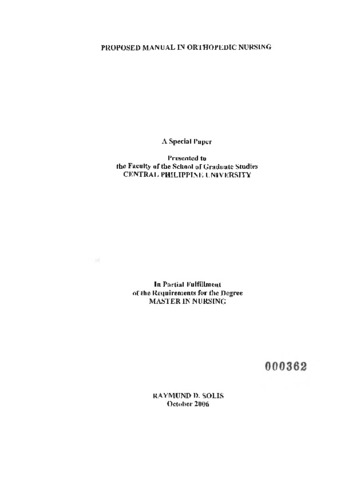Proposed manual in orthopedic nursing
| dc.contributor.adviser | Alibogha, Salex E. | |
| dc.contributor.author | Solis, Raymund D. | |
| dc.date.accessioned | 2021-10-01T00:57:34Z | |
| dc.date.available | 2021-10-01T00:57:34Z | |
| dc.date.issued | 2006 | |
| dc.identifier.citation | Solis, R. D. (2006). Proposed manual in orthopedic nursing (Unpublished Master’s thesis). Central Philippine University, Jaro, Iloilo City. | en_US |
| dc.identifier.uri | https://hdl.handle.net/20.500.12852/1451 | |
| dc.description | Introduction and statement of the problem | en_US |
| dc.description.abstract | This manual is the realization of the author’s dream way back in college. The admiration he had to his mentors who made syllabi which served as references making learning organized and easy, left an open vision in his mind and pledge to himself that if given the chance, he is going to make such learning material in the future. The author’s vision or dream was reawakened when he had his preceptorship training at the Philippine Orthopedic Center (POC) and when he was following up students in their clinical exposure in the said institution. He realized that the allotted forty hours of related learning experience (RLE) is insufficient for the students to acquire the necessary knowledge they need to learn about orthopedic nursing. The author was also confronted with the reality that no one book is enough to supply the students with the necessary knowledge and skills they need to learn, thus instructors utilized several references. It is also a known fact that nursing books are very expensive. Students also clamor that they cram for references if they have reports or case study because the references available in the library are limited (not enough to the number of users). The inadequacy of references causes the students to spend a lot to photocopy reference materials or in internet surf. With the ballooning enrollment of the colleges of nursing, the need for classroom and clinical instructors to handle the lecture and to follow up students in the clinical area also heightened. The lack of reference materials causes apprehension to the instructors to handle the subject. These are the factors that motivated the author to pursue his dream of creating a manual that will serve as a reference material to assist in the teaching and learning of orthopedic nursing concepts, thus the materialization of this manual. General Objective At the end of the discussion of the concept of musculoskeletal system utilizing different teaching modalities, the learners will be able to acquire knowledge on orthopedic nursing, develop skills in the management of orthopedic patients and demonstrate the desired attitude in the care of these patients. Specific Objectives Specifically, the learners are expected to: A. KNOWLEDGE 1. Discuss the principles of tractions, its purposes and indications; 2. Explain comprehensively orthopedic conditions and its management; 3. Classify different types of tractions, casts, molds and braces; 4. Enumerate types of orthopedic hardware and familiarize their indications; 5. Identify assistive devices and discuss their uses; 6. Give health teachings to the patient regarding personal care, rehabilitation and proper diet 7. Identify nursing diagnoses, formulate objectives and enumerate nursing interventions specific to the needs of the patient. B. SKILLS 1. Demonstrate skills in the care of patients with Balance Skeletal Traction; C. ATTITUDE 1. Demonstrate positive attitude in giving nursing care to clients with musculoskeletal disorders. PURPOSES OF THE MANUAL This manual is created as a response to the need for a learning instrument, specifically on orthopedic nursing. This manual can also be used as a teaching guide of instructors teaching this concept. The manual can be used by: • Instructors who teach the musculoskeletal concepts in the classroom; • Instructors who teach skills and those who follow up students in the clinical area, specifically in orthopedic nursing; • BSN students who want to enrich their knowledge and skills in orthopedic nursing and learn by themselves even without the supervision of an instructor or formal classroom discussion; and • BSN III students who are scheduled to have their affiliation in orthopedic nursing. | en_US |
| dc.format.extent | viii, 102 leaves | en_US |
| dc.language.iso | en | en_US |
| dc.subject.ddc | GSL Theses 610.73072 So45 | en_US |
| dc.subject.lcsh | Orthopedic nursing | en_US |
| dc.subject.lcsh | Orthopedic nursing--Handbooks, manuals, etc | en_US |
| dc.subject.lcsh | Orthopedic nursing--Study and teaching (Higher) | en_US |
| dc.subject.lcsh | Orthopedics | en_US |
| dc.subject.lcsh | Orthopedics--Study and teaching | en_US |
| dc.subject.lcsh | Handbooks and manuals | en_US |
| dc.subject.lcsh | Nursing--Handbooks, manuals, etc | en_US |
| dc.subject.mesh | Orthopedic Nursing | en_US |
| dc.subject.mesh | Orthopedics | en_US |
| dc.title | Proposed manual in orthopedic nursing | en_US |
| dc.type | Thesis | en_US |
| dc.description.bibliographicalreferences | Includes bibliographical references | en_US |
| dc.contributor.chair | David, Fely P. | |
| dc.contributor.committeemember | Delicana, Lilia A. | |
| dc.contributor.committeemember | Fullon, Ruby F. | |
| dc.contributor.department | School of Graduate Studies | en_US |
| dc.description.degree | Master in Nursing | en_US |
Fichier(s) constituant ce document
Ce document figure dans la(les) collection(s) suivante(s)
-
Master in Nursing [37]


